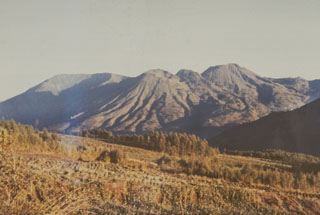Report on Dieng Volcanic Complex (Indonesia) — February 1979
Scientific Event Alert Network Bulletin, vol. 4, no. 2 (February 1979)
Managing Editor: David Squires.
Dieng Volcanic Complex (Indonesia) Gas emission kills nearly 200
Please cite this report as:
Global Volcanism Program, 1979. Report on Dieng Volcanic Complex (Indonesia) (Squires, D., ed.). Scientific Event Alert Network Bulletin, 4:2. Smithsonian Institution. https://doi.org/10.5479/si.GVP.SEAN197902-263200
Dieng Volcanic Complex
Indonesia
7.2°S, 109.879°E; summit elev. 2565 m
All times are local (unless otherwise noted)
Gas containing CO2 and H2S was ejected from Sinila Crater at 0330 on 20 February, killing (at latest report) 182 persons and injuring about 1,000, over 100 of whom had to be hospitalized [but see 4:3]. A police colonel said that 17,000 people had been evacuated from six villages near Sinila. A number of livestock were also killed by the gas, and ponds near the crater were covered with dead fish.
An AP wirephoto showed bodies of some of the victims, who did not appear to be burned, nor were they covered with ash. Nearby vegetation also appeared burned. Many of the fatalities occurred in the village of Bandjarnegara, located in a valley on Dieng's SW flank.
The gas emission from Sinila was preceded by seven felt earthquakes and followed by ejection of "smoke." UPI reported that "lava continued to pour over the slopes of the Dieng Plateau" on 20 February. Sikidang Crater is located in the summit caldera, 27 km NE of Bandjarnegara, and is said to be 11 km from Sinila Crater.
Geological Summary. The Dieng plateau in the highlands of central Java is renowned both for the variety of its volcanic scenery and as a sacred area housing Java's oldest Hindu temples, dating back to the 9th century CE. The Dieng Volcanic Complex consists of multiple stratovolcanoes and more than 20 small Pleistocene-to-Holocene craters and cones over a 6 x 14 km area. Prahu stratovolcano was truncated by a large Pleistocene caldera, which was subsequently filled by a series of cones, lava domes, and craters, many containing lakes. Lava flows cover much of the plateau, but observed activity has been restricted to minor phreatic eruptions. Gas emissions are a hazard at several craters and have caused fatalities. There are abundant thermal features and high heat flow across the area.
Information Contacts: AFP; Jakarta DRS; Antara News Agency, Jakarta; AP; UPI; Reuters; S. Russell, USGS.

